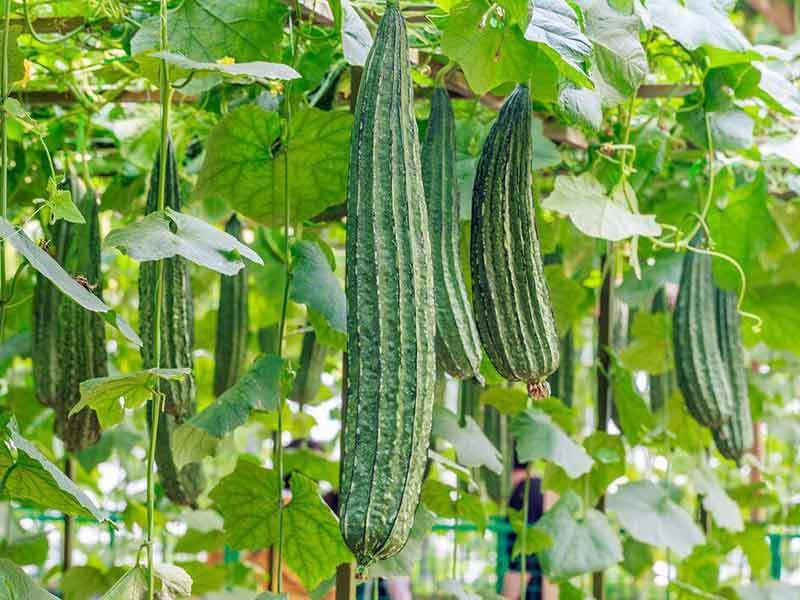Unlocking the Secrets of Growing Loofah in Canada
Introduction
Loofahs should stay year-round in a hot, sunny environment. So you can grow luffa in Canada by using a greenhouse. You can start growing loofahs in your backyard with this guide.
Understanding Loofah
What Is A Loofah?
Loofah is scientifically known as Luffa aegyptiaca. It is a member of the cucumber and gourd family. Native to the Middle East and Asia, Loofah has been cultivated for centuries for its edible fruit. But more commonly recognized for its fibrous skeleton. People use them to make sponges. These sponges become dry and fibrous after the plant has been allowed to mature and die.
Natural Loofahs Vs. Synthetic Loofahs
There are two primary types of loofah sponges on the market: natural and synthetic. Natural loofahs come from the dried fibrous materials of loofah plants. They are biodegradable and grown sustainably.
Synthetic loofahs, on the other hand, are made from plastic and are not biodegradable. The natural loofah is a favorite for health and beauty needs. It provides a good exfoliant without being too coarse.
Preparing for Loofah Cultivation
Selecting the Right Variety of Loofah Seeds
Loofah seed varieties can vary widely, just as the climates in which they thrive. Opt for Canadian-friendly seeds that have been tested in cool conditions. Some varieties have been known to adapt well to Canadian weather patterns. For example, Luffa Cylindrica.
Soil Requirements and Preparing the Soil
Loofah enjoys well-draining soil rich in organic matter. Compost and leaf mold can be your best friends here. Amend your garden beds or plastic flower pots with the right mix several weeks before growing luffa in Canada. This gives the organic material a chance to integrate with the existing soil.
Climate Considerations and Ideal Growing Conditions
Loofah thrives in warm, humid conditions. In some parts of Canada, it means a late-may planting date. To accommodate the plant's need for warmth, consider starting seeds indoors in peat pots or similar containers. Then, transfer them after the last frost. Place loofahs in a location with plenty of sunlight and retain moisture. For example, near a south-facing wall or in a greenhouse.

Planting and Caring for Loofah
How to Grow Loofah in Canada?
Sow your loofah seeds after the last frost of spring. Make sure the soil temperature is consistently above 21°C. Plant seeds about 1 inch deep and 24 inches apart when growing loofah in Canada. You should provide a trellis or pergola for the plant to climb. These vines can grow up to 30 feet or more!
Watering and Irrigation Techniques
Loofah plants love moisture but they are also sensitive to over-watering. During the germination period, keep the soil consistently moist but avoid waterlogging the soil. After they establish, loofah plants need about an inch of water per week. You should supply manual watering when there is no rain.
Fertilization and Nutrient Requirements
Fertilize your loofah plants when they begin to set fruit. You can use a balanced, water-soluble fertilizer throughout the growing season about once a month. Too much nitrogen can lead to lots of vine growth with little fruit. So keep an eye on the fertilizer ratio.
Managing Pests and Diseases Organically
Loofah plants can be prone to common cucumber family pests. For example, cucumber beetles and powdery mildew. Organic pest and disease control methods include regularly checking plants for pests, spraying neem oil, and hand-picking beetles. Avoiding overhead watering can also help prevent powdery mildew.
Supporting Loofah Growth
Providing Adequate Support
Install trellises, fences, or any vertical structures capable of withstanding the weight of mature loofah vines. Position these supports before growing luffa in Canada. So as not to disturb the roots. The height of the support can vary but should generally be at least six feet tall.
Pruning and Training Techniques
Maintain a single main vine and remove side shoots periodically. This encourages upward growth and focuses energy on fruit production. Use soft twine or similar materials to gently tie the main vine to the support structure. Training it upward as it grows.
Monitoring Growth Progress
Inspect your loofah regularly to identify when it's time to begin training and redirecting the growth. Be prepared to make adjustments to the support system as the plant develops. Always check for any signs of stress or disease.
Harvesting and Processing Loofah
Signs of Readiness for Harvesting
Loofahs are ready to harvest when they turn from green to yellow and harden. You should be able to feel and hear the seeds rattle inside when they're mature. If you wait too long, the loofah will become brown and brittle. This is also a sign of readiness. But you risk losing some of the sponge's flexibility.
Harvesting Techniques to Avoid Damage
When you're ready to harvest, use pruning shears or a sharp knife to cut the luffa from the vine, leaving a small stem attached. Be careful not to bruise or damage the sponge. This can lead to rot during the drying process.
Drying and Curing Loofahs
After harvesting, wash the luffa with water to remove any dirt or debris. Then, soak the sponges in a mild bleach solution to prevent mold, and rinse thoroughly. Hang the luffahs in a warm, dry place with good air circulation to dry. It can take several weeks for the sponges to completely dry and cure.
Storage Tips to Maintain Loofah Quality
Once your loofahs are dried and cured, store them in a cool, dry place away from direct sunlight. With proper care, your homegrown loofah sponges can last for years. This provides a renewable source of exfoliation for you and your family.
Conclusion
Growing loofah in Canada requires patience and care. You will become a successful loofah gardener with the right techniques and a little gardening savvy.

